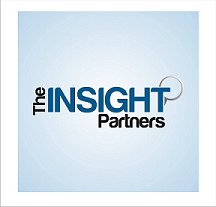
Smart Water Meters Market to reach US$ 1,506.2 Mn in 2017 and is also estimated to reach US$ 3,832.0 Mn by 2025

Smart Water Meter
The global smart water meter market is expected to reach US$ 3.8 billion in 2025, registering a CAGR of 12.4% during the forecast period 2018 to 2025.
PUNE, MAHARASHTRA, INDIA, December 9, 2019 /EINPresswire.com/ -- According to the new research report published by The Insight Partners, titled “Smart Water Meter Market - Global Analysis and Forecast to 2025”, the global smart water meter market is expected to reach US$ 3.8 billion in 2025, registering a CAGR of 12.4% during the forecast period 2018 to 2025.
In 2017, North America accounted for the largest revenue share of little more than two-fifth of the total market share, followed by Europe.
As per the United Nations Department of Economic and Social Affairs, close to 1.8 Billion people was suffering from acute water shortage problems by the year 2025 as well as more than two-thirds of the population was facing the constraints of limited water usage. The water paucity issues witnessed across the world has called for various stakeholders in diverse water usage fields to come together and develop for solutions that would result in water savings and sustainable usage of water for future generations.
Get Sample PDF Report @ https://www.theinsightpartners.com/sample/TIPTE100000347/
The Top of Smart Water Meter Market Companies are: ARAD Group, DIEHL Metering Group., Elster, Kamstrup A/S, Mueller, Sensus, Neptune Technologies, Badger Meters, Itron, Aclara Technologies LLC
North America, and Europe have developed water infrastructures but face the problems of aging water infrastructures whereby huge physical losses of water is experienced from the leaks and bursts developed. This adds to the cost for Government bodies, thereby adding to the economic cost of non-revenue water which further impacts customer satisfaction as well as quality of life. Apart from the developed region, the developing regions face other issues related to water supplies that is the high non-revenue water costs, water theft and inaccurate billing of water. Smart water meters look to provide solutions to the water utilities across the globe and enable them achieve good accountability of water, reduce leakage and water thefts, and also optimize water usage at the customer end. Although smart water meter systems had been developed around 2 decades ago, they have gained wider and rising prominence only in the recent times with increasing water scarcity around the world.
The public drinking water systems are regulated by the Environmental Protection Agency (EPA) in the US. There are close to 151,000 public water systems in the US 100,700 non-community water systems such as schools and hospitals. On the basis of the number of people served by a public water system, it is classified under three broad categories as Community Water System (CWS), Non-Transient Non-Community Water System (NTNCWS), and Transient Non-Community Water System (TNCWS). These different water systems drastically vary in size, and the top 8% of the water systems serve water to 82% of the total North American population. The average age of these systems is very high and most of the systems are nearing their product lifecycle ends. As a result, more cases of water leakages are observed. More than 240,000 breaks occur each year and the region loses close to 1.7 trillion gallons of water annually.
Key findings of the study:
From a growth perspective, India in the Asia-Pacific region is anticipated to witness a lucrative CAGR growth rate of 8.5% during the forecast period.
Based on end-users, the industrial segment is projected to witness significant lucrative profitable opportunities with projected CAGR growth rate of 12.8%
Based on type, the advanced metering infrastructure segment is projected to grow with a CAGR of 15.6%
The advanced metering infrastructure is a wireless connectivity mechanism, which enhances the water consumption pattern on a daily basis. The mechanism is a two-way connectivity technology enabling the service provider and the end users to review the collected information and requesting for pricing signals. The advanced metering infrastructure enables on request interrogation with the service providers and end-users. Advanced metering infrastructure typically offers significant quantity payload of information such as cumulative kWh usage, peak kW demand, daily kWh usage, last interval demand, voltage, load profile, outage counts, outage logs, and tamper notification among others. Along with metering and analyzing the water consumption, advanced metering infrastructure facilitates various groups within the ecosystem ranging from planning departments, engineering solutions, asset management, and finance teams among others. The benefits of advanced metering infrastructure include; reduction in equipment and maintenance costs, and Improved theft and leakage detection.
The smart water meter market is bifurcated on basis of types such as automatic meter reader (AMR) and advanced metering infrastructure (AMI). The automatic meter readers are the conventional mechanism used to identify water leakage and illegal water tapping, while advanced metering infrastructure is an advanced wireless technology that is used for the same purpose. The benefit of advanced metering infrastructure over automatic meter readers is the two-way communication network which allows both, the mechanism as well as the service provider or end user to transmit signals. The automatic meter reading technology is heavily deployed in the various regions across the globe, while, the advanced metering infrastructure is gaining prominence in the current scenario.
Purchase a Copy of Report Click Here https://www.theinsightpartners.com/buy/TIPTE100000347/
Sameer Joshi
The Insight Partners
+91 9666111581
email us here
EIN Presswire does not exercise editorial control over third-party content provided, uploaded, published, or distributed by users of EIN Presswire. We are a distributor, not a publisher, of 3rd party content. Such content may contain the views, opinions, statements, offers, and other material of the respective users, suppliers, participants, or authors.

